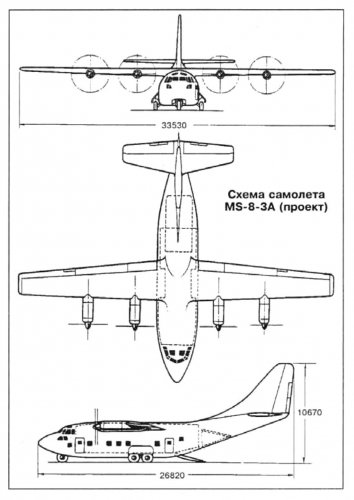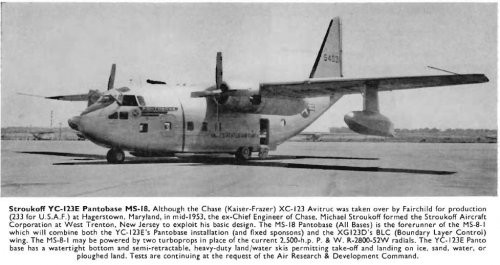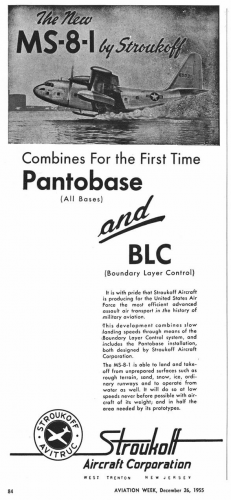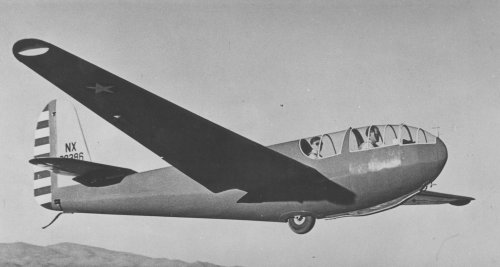You are using an out of date browser. It may not display this or other websites correctly.
You should upgrade or use an alternative browser.
You should upgrade or use an alternative browser.
Stroukoff and Chase (MS-) designations
- Thread starter _Del_
- Start date
- Joined
- 26 May 2006
- Messages
- 32,639
- Reaction score
- 11,811
_Del_ said:Looks like MS-17 was the internal designation for the YC-123D.
http://www.e-yearbook.com/yearbooks/United_States_Naval_Academy_Lucky_Bag_Yearbook/1955/Page_620.html
Thank you Del;
but they mentioned that; MS-17 and MS-18 were a cargo assault airplanes.
- Joined
- 25 June 2009
- Messages
- 13,735
- Reaction score
- 2,915
hesham said:but they mentioned that; MS-17 and MS-18 were a cargo assault airplanes.
And what were the C-123s in Vietnam, if not cargo assault airplanes?!
The Chase company and subsequent Stroukoff used the MS- designations after Michael Stroukoff. He designed the cargo gliders and the C-123A, which all led to the Fairchild C-123B, and also did the YC-134A Pantobase/BLC version of the Provider.
_Del_
I really should change my personal text... Or not.
- Joined
- 4 January 2012
- Messages
- 925
- Reaction score
- 981
Well we know what the MS-18 Pantobase was. It was the YC-123E. Contracted the same year as that ad.
And we know that the YC-123D used BLC and was contracted a year before the MS-18.
The YC-134 contract came a year after the year book entry and combined BLC and Pantobase. So it can't be MS-17.
And we know that the YC-123D used BLC and was contracted a year before the MS-18.
The YC-134 contract came a year after the year book entry and combined BLC and Pantobase. So it can't be MS-17.
- Joined
- 26 May 2006
- Messages
- 32,639
- Reaction score
- 11,811
Hi,
the Stroukoff MS-8--3A project was a four engined version of Chase/Fairchild
C-123 aircraft.
http://alternathistory.org.ua/otets-s-123-transportnye-samolety-mikhaila-strukova-ssha#
[mistake fixed and image removed, replaced further below by better quality version from redstar72—Mod.]
the Stroukoff MS-8--3A project was a four engined version of Chase/Fairchild
C-123 aircraft.
http://alternathistory.org.ua/otets-s-123-transportnye-samolety-mikhaila-strukova-ssha#
[mistake fixed and image removed, replaced further below by better quality version from redstar72—Mod.]
Jos Heyman
ACCESS: Top Secret
- Joined
- 15 February 2007
- Messages
- 597
- Reaction score
- 53
Does any of you speak and read Russian so that we can have a translation of the caption that goes along with the picture on the original website. Am I right in thinking this was an alternative to the C-130?
- Joined
- 25 June 2009
- Messages
- 13,735
- Reaction score
- 2,915
Jos Heyman said:Does any of you speak and read Russian so that we can have a translation of the caption that goes along with the picture on the original website. Am I right in thinking this was an alternative to the C-130?
Possibly, but that's not what the text says. According to the Google translator, it says that Lockheed « jealously watched the progress of the small "Russian" company »!!!
Jos Heyman
ACCESS: Top Secret
- Joined
- 15 February 2007
- Messages
- 597
- Reaction score
- 53
Thanks for that. Now I am beginning to be slightly worried.
First of all the website where Hesham found this is called 'alternate history' and, if I interpret that correctly, they provide 'alternatives' and that might very well include alternative (and specualitev) aircraft designs.
Also, having checked through references on Stroukoff designations I found MS-1 (Chase CG-14), MS-7 (Chase C-122), MS-8 (Chase XCG-20), MS-18 (Fairchild YC-123E) as well as 'blank' references to MS-17, MS-26 and MS-29. So, the designation MS-3-3A seems to be a bit out of sequence, even though the C-134 was known as MS-8-1.
May be we we should collective try to get all MS designations.
First of all the website where Hesham found this is called 'alternate history' and, if I interpret that correctly, they provide 'alternatives' and that might very well include alternative (and specualitev) aircraft designs.
Also, having checked through references on Stroukoff designations I found MS-1 (Chase CG-14), MS-7 (Chase C-122), MS-8 (Chase XCG-20), MS-18 (Fairchild YC-123E) as well as 'blank' references to MS-17, MS-26 and MS-29. So, the designation MS-3-3A seems to be a bit out of sequence, even though the C-134 was known as MS-8-1.
May be we we should collective try to get all MS designations.
- Joined
- 25 June 2009
- Messages
- 13,735
- Reaction score
- 2,915
Here is what I have managed to collect over the years:
MS-1 USAAF XCG-14 assault glider (1944)
MS-1? USAAF XCG-14A assault glider (1945)
MS-3 Heavy assault glider proposal (1947)
MS-3A USAF XCG-20 > XG-20 (1948)
MS-5 USAAF (X)TG-12 Bowlus training glider
MS-6 USAF XCG-18A, formerly known as XCG-14B (1948)
MS-6A USAF YCG-18A > YG-18A (1948)
MS-7 USAF YC-122 AVITRUC (1948)
MS-7A? USAF YC-122A AVITRUC (1948)
MS-7B? USAF YC-122B AVITRUC (1948)
MS-7C USAF YC-122C AVITRUC (1949)
MS-7 civil conversions of AVITRUC
MS-8 USAF XC-123 AVITRUC
MS-8 USAF XC-123A, C-123A AVITRUC
MS-8-1* USAF YC-134 PANTOBASE, a.k.a. BLC-PANTOBASE Assault Transport (1956)
MS-8-1* USAF YC-134A PANTOBASE, modified with Wright J-30 engines and tail fin extended forward (1958)
MS-8-3A* Projected four-engine version with redesigned swept tail and four Rolls-Royce Dart 510 engines
MS-9 Long-range, high-speed transport project, capable of trans-ocean delivery of very large payloads (1950)
MS-11 US Navy VA Class ASW aircraft proposal to OS-117 (April 1950)
MS-17* USAF YC-123D Boundary Layer Control cargo assault airplane, modified from Fairchild Provider (1954)
MS-18* USAF YC-123E PANTOBASE, forerunner of the MS-8-1 (1955)
MS-19 Cargo transport project, a commercial version of the C-123B (1952)
MS-24W* C-123 derivative with radomes submitted to Navy for CIC mission in the mid-1950s (thanks, Craig!)
MS-26* US Navy VT Class basic jet trainer proposal to U.S. Navy's OS-141 specification
Jos Heyman also mentions an MS-29 reference with no further information.
Aircraft types marked with an asterisk (*) were done after 1953 under the Stroukoff Aircraft Corp.
MS-1 USAAF XCG-14 assault glider (1944)
MS-1? USAAF XCG-14A assault glider (1945)
MS-3 Heavy assault glider proposal (1947)
MS-3A USAF XCG-20 > XG-20 (1948)
MS-5 USAAF (X)TG-12 Bowlus training glider
MS-6 USAF XCG-18A, formerly known as XCG-14B (1948)
MS-6A USAF YCG-18A > YG-18A (1948)
MS-7 USAF YC-122 AVITRUC (1948)
MS-7A? USAF YC-122A AVITRUC (1948)
MS-7B? USAF YC-122B AVITRUC (1948)
MS-7C USAF YC-122C AVITRUC (1949)
MS-7 civil conversions of AVITRUC
MS-8 USAF XC-123 AVITRUC
MS-8 USAF XC-123A, C-123A AVITRUC
MS-8-1* USAF YC-134 PANTOBASE, a.k.a. BLC-PANTOBASE Assault Transport (1956)
MS-8-1* USAF YC-134A PANTOBASE, modified with Wright J-30 engines and tail fin extended forward (1958)
MS-8-3A* Projected four-engine version with redesigned swept tail and four Rolls-Royce Dart 510 engines
MS-9 Long-range, high-speed transport project, capable of trans-ocean delivery of very large payloads (1950)
MS-11 US Navy VA Class ASW aircraft proposal to OS-117 (April 1950)
MS-17* USAF YC-123D Boundary Layer Control cargo assault airplane, modified from Fairchild Provider (1954)
MS-18* USAF YC-123E PANTOBASE, forerunner of the MS-8-1 (1955)
MS-19 Cargo transport project, a commercial version of the C-123B (1952)
MS-24W* C-123 derivative with radomes submitted to Navy for CIC mission in the mid-1950s (thanks, Craig!)
MS-26* US Navy VT Class basic jet trainer proposal to U.S. Navy's OS-141 specification
Jos Heyman also mentions an MS-29 reference with no further information.
Aircraft types marked with an asterisk (*) were done after 1953 under the Stroukoff Aircraft Corp.
- Joined
- 25 June 2009
- Messages
- 13,735
- Reaction score
- 2,915
hesham said:the Stroukoff MS-3-3A project was a four engined version of Chase/Fairchild C-123 aircraft.
Jos Heyman said:the designation MS-3-3A seems to be a bit out of sequence, even though the C-134 was known as MS-8-1.
Considering the dates, general arrangement and lousy quality of the scan, I came to the conclusion that this picture actually depicts a version called the MS-8-3A, a variant of the C-123/C-134 (an ill-scanned "8" looks a lot like a "3"). "MS-3" would be a much earlier design.
- Joined
- 7 June 2009
- Messages
- 525
- Reaction score
- 126
Stargazer2006 said:Considering the dates, general arrangement and lousy quality of the scan, I came to the conclusion that this picture actually depicts a version called the MS-8-3A, a variant of the C-123/C-134 (an ill-scanned "8" looks a lot like a "3"). "MS-3" would be a much earlier design.
You are absolutely right, Stephane - the designation is MS-8-3A. Here is a better scan.
According to the article, this project with four turboprops, boundary layer control and PANTOBASE equipment was proposed after successful XC-123E tests. But USAF preferred the version with two more powerful piston engines, which was built as the YC-134.
Jos Heyman said:First of all the website where Hesham found this is called 'alternate history' and, if I interpret that correctly, they provide 'alternatives' and that might very well include alternative (and specualitev) aircraft designs.
Yes of course, but not in this case. This article is fully historical. By the way, it is placed in the "Real history" subforum.
Actually this article is taken from Aviatsiya i Vremya (Aviation & Time) magazine, No.2/1996. Unfortunately comrade Serg, when reposted it for the Alternathistory site, forgot to specify the source and author (who is actually Vadim Mikheev).
About aviation topics on Alternathistory: those from http://alternathistory.org.ua/forum/1434 subforum ("Less known and unrealized aircraft designs") are historical, while those from http://alternathistory.org.ua/forum/1896 ("Alternative aviation") are what-ifs. At least it's what must have been - there are some topics placed in "wrong" sections.
Attachments
Jos Heyman
ACCESS: Top Secret
- Joined
- 15 February 2007
- Messages
- 597
- Reaction score
- 53
Gentlemen
Thank you for clarifying all this and the additional info.
I would like to have some more information on the MS-5/Bowlus XTG-12 connection.
From my research, it is clear that three XTG-12s were ordered on 28 April 1942 although none were built. However, one existing Bowlus glider was impressed as XTG-12 with serial 42-57200. There is also mention of an XTG-12A. Other sources have suggested three Bowlus gliders were impressed. There is a picture of a two seat Bowlus XBM-5 glider, registered NX28386 that flew in 1942 and may have been one of the XTG-12s.
With Michael Stroukoff starting his own company in February 1942, I find it difficult to beloeve that he could have been involved in the XTG-12 work, the more so as Bowlus operated in California on the west coast and Stroukoff operated at on the east coast. May be Michael Stroukoff built a Bowlus glider from a kit, or whatever, (for pleasure or research), but, if that's the case, I would suggest the XTG-12 link is not correct. But, may be there is additional information to explain all this further and allows us to clear up another aviation historical question.
Thank you for clarifying all this and the additional info.
I would like to have some more information on the MS-5/Bowlus XTG-12 connection.
From my research, it is clear that three XTG-12s were ordered on 28 April 1942 although none were built. However, one existing Bowlus glider was impressed as XTG-12 with serial 42-57200. There is also mention of an XTG-12A. Other sources have suggested three Bowlus gliders were impressed. There is a picture of a two seat Bowlus XBM-5 glider, registered NX28386 that flew in 1942 and may have been one of the XTG-12s.
With Michael Stroukoff starting his own company in February 1942, I find it difficult to beloeve that he could have been involved in the XTG-12 work, the more so as Bowlus operated in California on the west coast and Stroukoff operated at on the east coast. May be Michael Stroukoff built a Bowlus glider from a kit, or whatever, (for pleasure or research), but, if that's the case, I would suggest the XTG-12 link is not correct. But, may be there is additional information to explain all this further and allows us to clear up another aviation historical question.
The Bushranger
ACCESS: Restricted
- Joined
- 24 January 2010
- Messages
- 11
- Reaction score
- 0
These look quite fascinating indeed - is there more info somewhere out there on them?Skyblazer said:MS-11 US Navy VA Class ASW aircraft proposal to OS-117 (April 1950)
MS-26* US Navy VT Class basic jet trainer proposal
- Joined
- 25 June 2009
- Messages
- 13,735
- Reaction score
- 2,915
The Bushranger said:These look quite fascinating indeed - is there more info somewhere out there on them?Skyblazer said:MS-11 US Navy VA Class ASW aircraft proposal to OS-117 (April 1950)
MS-26* US Navy VT Class basic jet trainer proposal
Only in the Spangenberg archives, and I don't think they are accessible for the time being. But maybe someone has an update on that?
- Joined
- 25 June 2009
- Messages
- 13,735
- Reaction score
- 2,915
I have updated my Stroukoff list, fixing a couple of mistakes and adding designations found since.
It's still in the same post, which can be found here: https://www.secretprojects.co.uk/forum/index.php/topic,17666.msg168504.html#msg168504
It's still in the same post, which can be found here: https://www.secretprojects.co.uk/forum/index.php/topic,17666.msg168504.html#msg168504
- Joined
- 25 June 2009
- Messages
- 13,735
- Reaction score
- 2,915
Jos Heyman said:I would like to have some more information on the MS-5/Bowlus XTG-12 connection.
From my research, it is clear that three XTG-12s were ordered on 28 April 1942 although none were built. However, one existing Bowlus glider was impressed as XTG-12 with serial 42-57200. There is also mention of an XTG-12A. Other sources have suggested three Bowlus gliders were impressed. There is a picture of a two seat Bowlus XBM-5 glider, registered NX28386 that flew in 1942 and may have been one of the XTG-12s.
With Michael Stroukoff starting his own company in February 1942, I find it difficult to beloeve that he could have been involved in the XTG-12 work, the more so as Bowlus operated in California on the west coast and Stroukoff operated at on the east coast. May be Michael Stroukoff built a Bowlus glider from a kit, or whatever, (for pleasure or research), but, if that's the case, I would suggest the XTG-12 link is not correct. But, may be there is additional information to explain all this further and allows us to clear up another aviation historical question.
According to Peter Bowers (and whatever info he had at his disposal in 1957, when he wrote this, in the Nov.-Dec. issue of Soaring):
"[The] two-place Model BA-102" "a rare and little-known member of the famous Bowlus family of sailplanes, designed by William Hawley Bowlus", "was submitted to the Army for consideration as a trainer under the designation of XTG-12.
Back in 1941, when the Army was just starting a glider program, two-place sailplanes were used for initial training. (...) New designs, mostly of wood to conserve scarce metals, were developed for military consideration after the program had begun using sailplane trainers. The Briegleb BG-8 (XTG-13) is a well-known example, along with the BA-102.
The BA-102 was a clean and simple design, with a minimum of compound curves. The wing position was a true mid-wing, with the seating arrangement rather unusual for a two-place ship, in that the rear cockpit was ahead of the wing spar. This provided much better visibility for the rear occupant than was available in the TG-2's, 3's and 4's, in which the rear cockpit was behind the main spar of the mid or low wing. The fuselage was of semi-monocoque plywood construction. Wing span was 44 feet 8 inches, length 19 feet 4 inches, and the empty weight was 450 pounds. L/D was given as 20:1.
Shortly after the Bowlus and Briegleb were submitted for test, the Army glider program underwent a change of policy, under which it was decided that the training of pilots who were to fly the boxy cargo gliders should not be started in sailplanes. Orders that had been placed for additional sailplane types were cancelled, and those already on hand were declared surplus. From that time on, glider training was given in de-engined Cubs and Taylorcrafts that had performance characteristics closer to that of the cargo gliders.
It would be interesting to know what happened to the BA-102/XTG-12 after this. (...) No mention of a Bowlus BA-102 shows in postwar CAA glider listings, however."
From my own research into Bowlus gliders, I found that only one example of the BA-102 had been constructed, but no registration could be found for it. However, there was an XBM-5 registered as [NX28386]. Now if the BA-102 and XBM-5 are one and the same glider, it makes sense. It also makes sense that the type may have been built as a civilian type, but that with the war situation going on, the glider was militarized and registered as such ("XBM" probably meant Experimental Bowlus, Military).
What could Stroukoff's involvement have been, if any? Did he design the wings of the XBM-5 for Bowlus? There is a whole five years between the evaluation of the XBM-5 and the time when Michael Stroukoff designated it as the MS-5. So he probably wasn't involved in it, and merely purchased it while at Chase Aircraft. And if the prototype wound up there, it makes sense that Peter Bowers could never find a trace of it. Now since Bowers said the type was meant as a trainer for cargo gliders, perhaps Stroukoff meant to use it exactly as such for his pilots? Still, that doesn't mean he had to designate it as a Stroukoff design, so I'd imagine he must have tinkered around with it somehow, modifying things here and there to make its handling even closer to the experience of full-scale cargo glider pilots.
But of course this is still speculation, so I'd appreciate your views on this!
Meanwhile, here's a beautiful photo of the XBM-5 (and the only one I know of it in flight):
Attachments
Similar threads
-
-
-
-
Morane-Saulnier MS 1000, MS 1010 and MS 1020 Jet Fighters
- Started by hesham
- Replies: 10
-
Morane-Saulnier Interwar Fighter Projects and Prototypes
- Started by hesham
- Replies: 17





